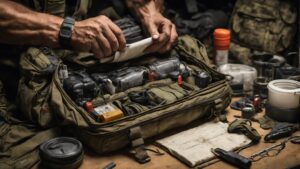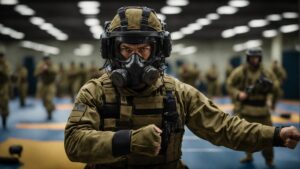What Items from the Survival Gear Checklist Are Essential for SHTF Situations?
Having an essential survival gear checklist is crucial, especially in SHTF situations. Items like a sturdy tent, waterproof matches, a multi-tool, and a reliable water filter should be prioritized. Additionally, don’t forget to include a first aid kit, durable clothing, a flashlight, and extra food and water supplies. Being prepared with these items can make a significant difference in survival during challenging times.
SHTF Survival Guide
Welcome to your SHTF (Sh*t Hits The Fan) Survival Guide! In times of crisis, being prepared is key to ensuring your safety and well-being. This comprehensive guide will equip you with the essential skills, knowledge, and resources needed to navigate through any disaster or emergency situation. From building your survival kit to understanding crucial survival techniques, let’s dive into the world of survival preparedness.

Essential Skills for Survival
When it comes to survival, having the necessary skills can make all the difference. Here are a few crucial skills to develop:1. First Aid and CPR
Knowing how to administer basic first aid and perform CPR can be a lifesaver. Take a certified course to learn these skills and stay up to date with current guidelines.2. Fire Starting
Having the ability to start a fire can provide warmth, cook food, and ward off potential threats. Learn the various methods, such as using matches, lighters, or friction techniques, to ensure you can start a fire in any situation.3. Navigation and Map Reading
Understanding how to read maps, use a compass, and navigate using natural landmarks are invaluable skills when it comes to finding your way in unfamiliar territory.4. Self-Defense
Being able to protect yourself in a crisis is crucial. Consider taking self-defense classes to learn essential techniques for personal safety.Building Your Survival Kit
Having a well-stocked survival kit is essential to ensure your basic needs are met in a crisis. Here are some items to include:- Water: Aim for at least one gallon of water per person per day.
- Non-perishable food: Stock up on canned goods, energy bars, and other long-lasting food items.
- First aid supplies: Include bandages, antiseptics, medications, and any necessary prescription drugs.
- Multi-tool or Swiss Army knife: These versatile tools can come in handy in a variety of situations.
- Emergency shelter: Carry a lightweight tent, emergency blankets, and a sturdy tarp for shelter options.
- Flashlight and extra batteries: Ensure you have a reliable light source for safety and visibility.
- Communication devices: A portable radio, whistle, and signal mirror can help you call for help in case of an emergency.
- Personal hygiene items: Include items like toilet paper, hand sanitizer, and wet wipes.
- Cash: Keep small bills on hand as ATMs and card payment systems may not be available.

Food and Water
In any survival situation, having access to food and clean water is vital. Here are some tips to ensure your nutritional needs are met:- Water: Learn how to properly filter and purify water from potentially contaminated sources. Invest in water purification tablets, a portable water filter, or a reliable water purification kit.
- Food: Opt for non-perishable items that are easy to carry and store. Canned goods, dried fruits, nuts, energy bars, and MREs (Meal Ready-to-Eat) are excellent choices. Be sure to rotate your food supply periodically to maintain freshness.
Shelter and Protection
Having a safe and secure shelter is vital for protection against the elements and potential threats. Consider these options:- Home: Ensure your home is well-prepared with sturdy doors and windows, reinforced locks, and ample emergency supplies.
- Bug-out bag: Prepare a portable bag containing essential items in case you need to evacuate quickly. Include items like extra clothing, hygiene supplies, a sleeping bag, fire-starting tools, and a portable stove.
- Natural shelters: Learn how to create makeshift shelters using materials from your surroundings, such as branches, leaves, or tarpaulins.
- Emergency shelters: Familiarize yourself with nearby emergency shelters, such as community centers or schools, in case you need to seek refuge.

Navigation and Signaling
Navigating through unfamiliar terrain and signaling for help are essential skills in a survival situation. Here’s what you need to know:- Maps and compass: Learn how to read maps and use a compass to navigate accurately. Familiarize yourself with topographic symbols and how to calculate distance and direction.
- Signaling devices: Carry signaling devices like a whistle, signal mirror, and flare gun to attract attention from potential rescuers.
- Natural navigation: Understand how to navigate using natural indicators like the sun, stars, and landmarks. Learn how to establish cardinal directions and follow them correctly.
Emergency Medical Care
Knowing basic emergency medical care can be life-saving in a crisis. Consider these key aspects:- First aid: Learn how to treat common injuries such as cuts, sprains, burns, and fractures. Know when to apply pressure, dress wounds, and perform CPR.
- Medications: Ensure you have a supply of necessary medications, including any prescription drugs you or your family members may require.
- Medical training: Take advanced courses to expand your medical knowledge, such as wilderness first aid or emergency response training.
Self-Defense and Security
In a post-SHTF scenario, personal safety becomes paramount. Here are a few self-defense and security considerations:- Situational awareness: Stay vigilant and be aware of your surroundings at all times. Avoid dangerous areas and trust your gut instincts.
- Self-defense training: Take self-defense classes or martial arts courses to learn effective techniques for personal protection.
- Home security: Reinforce your home’s security measures, such as installing security cameras, motion sensor lights, and sturdy locks.

Communication in Crisis
During an emergency, clear communication can save lives and provide valuable information. Consider these communication methods:- Portable radios: Invest in a battery-powered or hand-cranked portable radio to receive emergency alerts and stay informed about the situation.
- Signal flares: Use signal flares to alert nearby rescue teams or other survivors of your presence.
- HAM radio: Obtain a HAM radio license and equip yourself with a compact HAM radio to communicate over long distances.
Surviving Natural Disasters
Natural disasters can strike unexpectedly and cause significant damage. Here are some tips to help you survive various scenarios:- Earthquakes: Identify safe areas in your home and practice the “Drop, Cover, and Hold” technique. Secure heavy furniture and ensure you have an emergency supply of food, water, and other necessities.
- Hurricanes: Prepare for hurricane season by securing windows, trimming trees, and having a well-stocked emergency kit. Evacuate if necessary, and follow evacuation routes provided by local authorities.
- Wildfires: Create a defensible space around your home by removing dry vegetation and maintaining clearance around structures. Stay updated on the fire’s progress and be ready to evacuate if advised.
Psychological Preparedness
Surviving a crisis not only demands physical preparedness but also mental and emotional resilience. Here are some practices for psychological preparedness:- Stay informed: Stay updated with accurate information from reliable sources, but limit exposure to news that may cause anxiety or distress.
- Develop coping strategies: Establish healthy coping mechanisms like meditation, journaling, or talking to trusted friends and family.
- Build a support network: Connect with like-minded individuals or join community groups focused on survival and preparedness to share knowledge and provide emotional support.
In Conclusion
Congratulations! You have completed your comprehensive SHTF Survival Guide. By developing essential skills, building a well-stocked survival kit, ensuring access to food and water, securing shelter and protection, mastering navigation and signaling techniques, acquiring emergency medical care knowledge, understanding self-defense and security measures, establishing clear communication plans, preparing for natural disasters, and nurturing psychological preparedness, you are well on your way to being fully prepared for any emergency or disaster that may come your way. Stay safe, stay prepared, and trust in your own resourcefulness and resilience!
I’m Alex, the author behind True Survivalist. As a survival enthusiast myself, I’ve created this website to serve as a valuable resource for fellow survivalists and preppers. Whether it’s understanding survival situations, emergency preparedness, or finding the right survival gear, I’ve got you covered. Through a series of informative guides, I aim to provide answers to commonly asked questions, debunk common myths, and help you avoid common mistakes. At True Survivalist, I believe in equipping you with the knowledge and tools you need to be prepared for any survival scenario. Join me on this journey of self-reliance and resilience.
